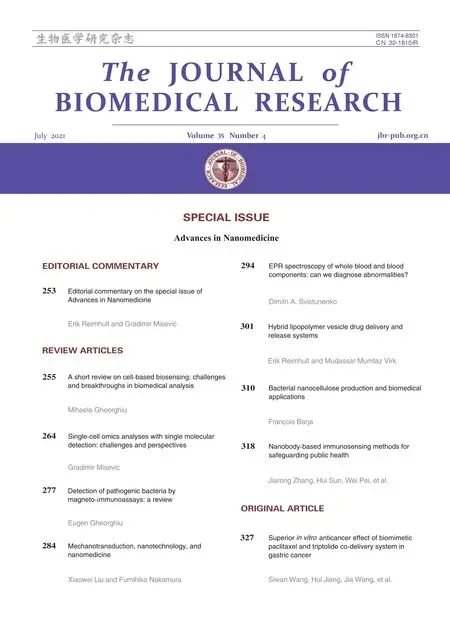Editorial commentary on the special issue of Advances in Nanomedicine
2021-12-09ErikReimhultGradimirMisevic
Erik Reimhult, Gradimir Misevic
1Department of Nanobiotechnology, Institute for Biologically Inspired Materials, University of Natural Resources and Life Sciences, Vienna, 1190 Vienna, Austria;
2Research and Development, Gimmune GmbH, 6302 Zug, Switzerland.
Nanomedicine is a vast multidisciplinary field of life sciences. It assembles branches of the fundamental research disciplines biology, physics, and chemistry with medicine and their associated application technologies and instrumentation. Diagnostics and therapeutics are the two major application areas of nanomedicine.
The diagnostics area covers molecular biology,genetics, and immunology research related to discovering and applying molecular biomarkers and specific analytical probes. Diagnostics in nanomedicine uniquely uses cutting-edge materials science and physics to improve biodistribution and sensitivity of diagnostic probes. Various natural and synthetic nanoparticles are used for this purpose, from lipid and polymer micelles and vesicles to inorganic, organic,and bioorganic nanoparticles. Such nanoparticles can be tailored to improve biodistribution by avoiding unintended interactions with biomolecules and the immune system while providing enhanced detection using fluorescent, magnetic, plasmonic, nucleic acid,and other bar codes permitting chemical and imaging detection modes. The ultimate goals of nanomedical diagnostics are the complete quantification of the biochemistry of single cells, equivalent to picoliter volume of bioliquids, as well as molecular target resolutionin vivoandin vitro. Hence, nanomedical probes both require and enable the development of instrumentation that can exploit their advantages.Particularly exciting is the potential to combine multiple readout formats through miniaturization, as demonstrated by micro- and nano-sized biosensor platforms. Advancing our understanding and application of nanotechnologies for biomarkers and analytical probes will permit more precise diagnosis and result in specific, personalized, and optimal therapeutic treatments.
Similarly, nanomedical therapeutics should enable precise delivery and clearance of drugs or other therapeutic tools, fulfilling the second goal of personalized medicine. The approach is exemplified by nanoparticles as drug carriers or therapeutic triggers.Guided by specific interactions with biomolecular targets and suppression of non-specific interactions,they simultaneously improve biodistribution and enrichment in the pathologic tissue. Finding materials compatible with biological systems on the nanoscale is essential for this vision, for which the industrial synthesis of biopolymers is attractive.
At its fullest, nanomedicine envisions targeted nanomedical devices that serve detection (targeting),imaging, and triggered release in individual composite nanoparticles, aided by advanced external analytical methods.
In this special issue, we have selected nine different topics that are presenting recent advances in nanomedicine. Five reviews cover novel analytical solutions using nanotechnology. We start by reviewing cell-based biosensing, which promises breakthroughs in biomedical analyses as an alternative to molecular bioreceptors[1]. The second review article pushes the limits with an overview of single-cell analysis,proposing that single-molecule detection could be achieved by combining mass spectrometry, scanning probe microscopy, and nucleic acid amplification for the quantification of biological markers using a"complete omics" approach[2]. Next, we review the detection of magnetically tagged and actuated bacteria using long-range surface plasmon and electrochemical impedance spectroscopy[3]. The fourth review discusses the role of mechanotransduction in biology and how nanotechnology could be used to measure changes in pathological states or even influence cells[4]. The final review in this section details using EPR spectroscopy to diagnose abnormalities of whole blood and blood components[5]. Our sixth review is dedicated to nanotechnological solutions to drug delivery in the form of vesicles that combine the best properties of known liposome delivery systems and self-assembled polymer capsules, so-called lipopolymersomes[6]. The seventh article reviews the properties of bacterial nanocellulose, its emerging industrial production, and clinical applications[7]. Our eighth original article is dedicated toin vitroanticancer effect of biomimetic paclitaxel and triptolide co-delivery system in gastric cancer[8]. The final article reviews the use of nanobody-based immunosensing methods for safeguarding the public health[9].
杂志排行
THE JOURNAL OF BIOMEDICAL RESEARCH的其它文章
- Superior in vitro anticancer effect of biomimetic paclitaxel and triptolide co-delivery system in gastric cancer
- Nanobody-based immunosensing methods for safeguarding public health
- Bacterial nanocellulose production and biomedical applications
- Hybrid lipopolymer vesicle drug delivery and release systems
- EPR spectroscopy of whole blood and blood components: can we diagnose abnormalities?
- Mechanotransduction, nanotechnology, and nanomedicine
